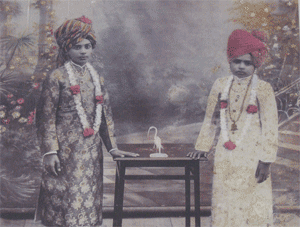Chandelao Garh was the seat of the Chandelao Thikana - an estate in the kingdom of Jodhpur. At its peak, Chandelao Thikana covered five villages. From the garh - or "kot" in the local language - the affairs of the estate were administered.
The Chandelao family belongs to the Rathore clan and to the subclan Kumpawat, or "the sons of Kumpa". Rao Kumpa was one of the greatest generals of Marwar, as the princely state of Jodhpur was known. The Maharajah of Jodhpur is the chief of the Rathore clan. The present Thakur and your host at Chandelao Garh - Praduman Singh Rathore - is the 16th in line from Rao Kumpa. Rao Kumpa was one of two Marwari generals who led 6,000 soldiers against the 80,000 troops of Sher Shah Suri, the Afghan ruler of Delhi in the battle of Sumelgiri in 1544 A.D. Rao Kumpa nearly won the battle, but was killed. Seeing this brave Rajput General, Emperor Sher Shah Suri said, "for a handful of bajra, I nearly lost the kingdom of Hindustan". His meaning was that he nearly lost his entire kingdom for the small gain of a victory over Marwar, which he compared to a handful of millet.
Chandelao Garh was built in 1744 by Rao Kumpa's grandson Rao Puranmal who had annexed Sirohi for the Maharajah of Jodhpur. The estate was granted by the Maharajah to Rao Puranmal for his bravery in battle and for providing a small cavalry for the Maharajah's army. In return for the estate, the Thakur maintained 8 horses for the Maharajah's cavalry and was himself expected to take part in any battles.
The revenue for the Chandelao Thikana came from the land it ruled. The farmers would cultivate the fields for the Thakur and in return would receive a share of the harvest. The shepherds were allowed to let their animals graze on the land in return for a share of their herd. In 1952, five years after Indian Independence, this feudal system was abolished. Land reforms were passed, and most of the land was allotted to the tenants. Further reforms in 1972 abolished feudal titles and redistributed most of the remaining land.
The central building of Chandelao Garh is the oldest and was built in 1744. This is the "raola", or the main living quarters. At that time the central building was surrounded by mud walls for protection. Later Thakurs added various elements of construction to the Garh, including the current high stone walls which were constructed in the early 19th century. Most of the Garh stands as it was constructed - except for the gate. It was reconstructed by Thakur Ugam Singh on the occasion of the marriage of his son, Kr. Umaid Singh, at the beginning of the 20th century. Umaid Singh could not ride through the gate seated on an elephant, so the Thakur ordered the gate to be rebuilt and replaced with a larger one so that a man sitting in a howdah on the back of an elephant could pass through!
 |